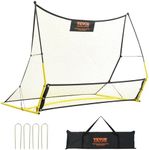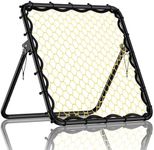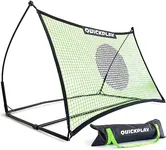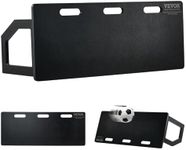Buying Guide for the Best Soccer Rebounders
Choosing the right soccer rebounder can make a big difference in your training, whether you're a beginner or an experienced player. A soccer rebounder is a piece of equipment that bounces the ball back to you, helping you practice passing, shooting, and ball control on your own. To find the best fit, think about where you'll use it, what skills you want to improve, and how much space you have. Understanding the key features will help you make a smart choice.SizeThe size of a soccer rebounder refers to its overall dimensions, which affect how much area you can use for practice. Larger rebounders give you more space to aim at and are great for practicing volleys, headers, and team drills, while smaller ones are more portable and better for close control and passing accuracy. If you have a big backyard or want to train with others, a larger rebounder might be best. For limited space or solo use, a compact model is easier to set up and store.
Rebound Surface TypeThe rebound surface is the part of the equipment that the ball bounces off. Some rebounders have a net, while others use a solid panel. Nets tend to give a more unpredictable bounce, which is good for reaction training, while solid panels offer a consistent return, ideal for practicing specific passes or shots. If you want to work on quick reflexes, choose a net surface. For more controlled drills, a solid panel might suit you better.
AdjustabilityAdjustability means whether you can change the angle or position of the rebounder. Adjustable rebounders let you practice different types of passes, volleys, and shots by changing how the ball comes back to you. Fixed rebounders only offer one type of return. If you want to work on a variety of skills, look for a model with adjustable angles. If you have a specific drill in mind, a fixed angle might be enough.
PortabilityPortability is about how easy it is to move and store the rebounder. Some models are lightweight and foldable, making them easy to carry to the park or store in a small space. Heavier, more solid rebounders are less portable but may be more stable during use. If you plan to move your rebounder often or have limited storage, look for a portable design. If it will stay in one place, stability might be more important.
DurabilityDurability refers to how well the rebounder holds up over time, especially with frequent use and exposure to weather. Materials like steel frames and weather-resistant nets or panels last longer and withstand hard shots. If you plan to use the rebounder outdoors or for intense training, choose a model made from strong, weatherproof materials. For occasional indoor use, lighter materials may be sufficient.
AssemblyAssembly is about how easy it is to set up and take down the rebounder. Some models require tools and more time to assemble, while others can be set up quickly without much effort. If you want something you can use right away or move frequently, look for a rebounder with simple, tool-free assembly. If you don’t mind spending time on setup and want a more permanent fixture, assembly complexity may be less of a concern.
















